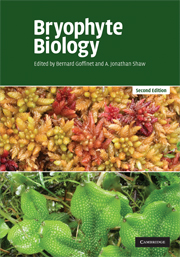Book contents
- Frontmatter
- Contents
- List of contributors
- Preface
- 1 Morphology and classification of the Marchantiophyta
- 2 Morphology, anatomy, and classification of the Bryophyta
- 3 New insights into morphology, anatomy, and systematics of hornworts
- 4 Phylogenomics and early land plant evolution
- 5 Mosses as model organisms for developmental, cellular, and molecular biology
- 6 Physiological ecology
- 7 Biochemical and molecular mechanisms of desiccation tolerance in bryophytes
- 8 Mineral nutrition and substratum ecology
- 9 The structure and function of bryophyte-dominated peatlands
- 10 Population and community ecology of bryophytes
- 11 Bryophyte species and speciation
- 12 Conservation biology of bryophytes
- Index
- References
6 - Physiological ecology
Published online by Cambridge University Press: 06 July 2010
- Frontmatter
- Contents
- List of contributors
- Preface
- 1 Morphology and classification of the Marchantiophyta
- 2 Morphology, anatomy, and classification of the Bryophyta
- 3 New insights into morphology, anatomy, and systematics of hornworts
- 4 Phylogenomics and early land plant evolution
- 5 Mosses as model organisms for developmental, cellular, and molecular biology
- 6 Physiological ecology
- 7 Biochemical and molecular mechanisms of desiccation tolerance in bryophytes
- 8 Mineral nutrition and substratum ecology
- 9 The structure and function of bryophyte-dominated peatlands
- 10 Population and community ecology of bryophytes
- 11 Bryophyte species and speciation
- 12 Conservation biology of bryophytes
- Index
- References
Summary
Introduction
Bryophytes are on average some two orders of magnitude smaller than vascular plants, and this difference of scale brings in its train major differences in physiology, just as many of the differences in the structural organization and physiology of insects and vertebrates are similarly scale-driven. Surface area varies as the square, and volume and mass as the cube, of linear dimensions. Hence gravity is a major limiting factor for vertebrates or trees, but trivial for insects or bryophytes. Bryophytes in general have much larger areas for evaporation in proportion to plant mass than do vascular plants. Surface tension, which operates at linear interfaces, is of little significance at the scale of the vascular plant shoot but is a powerful force at the scale of many bryophyte structures. There are also major scale-related differences in the relation of bryophytes and vascular plants to their atmospheric environment. Vascular-plant leaves are typically deployed in the turbulent air well above the ground. The diffusion resistance of the thin laminar boundary layer is small, so the epidermis with its cuticle and stomata in effect marks the boundary between (relatively slow) diffusive mass transfer within the leaf and (much faster) turbulent mixing in the surrounding air. By contrast the small leaves of many bryophytes lie largely or wholly within the laminar boundary layer of the bryophyte carpet or cushion, or of the substratum on which it grows.
- Type
- Chapter
- Information
- Bryophyte Biology , pp. 237 - 268Publisher: Cambridge University PressPrint publication year: 2008
References
- 29
- Cited by



